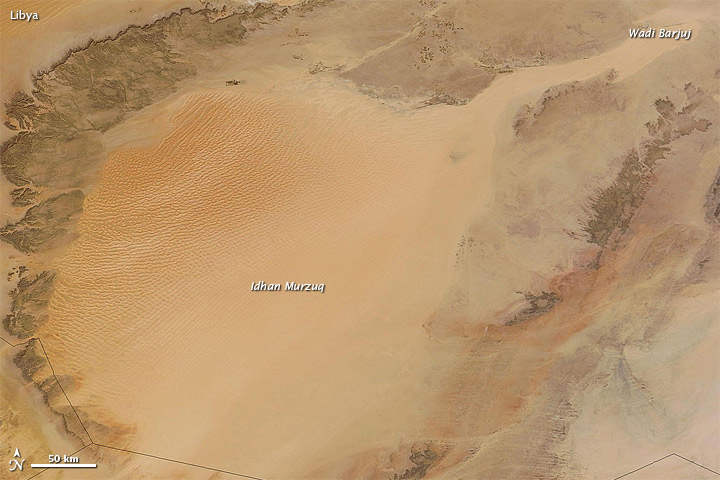File:Sand Sea in Southwestern Libya - NASA Earth Observatory.jpg
Sand_Sea_in_Southwestern_Libya_-_NASA_Earth_Observatory.jpg (720 × 480 pixels, file size: 100 KB, MIME type: image/jpeg)
Captions
Captions
Summary[edit]
| DescriptionSand Sea in Southwestern Libya - NASA Earth Observatory.jpg |
To download the full resolution and other files go to: earthobservatory.nasa.gov/IOTD/view.php?id=76652&src=... In southwestern Libya, near the borders of Algeria and Niger, lies a sand sea known as Idhan Murzuq (also Sahra Marzuq) that rarely receives water from either sky or land. The extreme desert’s complex dunes are shaped by dry winds. But extending from the northeast quarter, a corridor of sand lines what used to be a river channel: Wadi Barjuj. The Moderate Resolution Imaging Spectroradiometer (MODIS) on NASA’s Terra satellite captured this natural-color image on December 7, 2011. Sand dunes stand out especially in the northwestern part of Idhan Murzuq, though the entire sand sea contrasts with its rockier surroundings. A study published in 2008 and relying on data from multiple NASA sensors reconstructed Libya’s geology and hydrology over the past 7 million years. Over that span, Libya intermittently experienced humid, rainy conditions. One finding was that Wadi Barjuj was probably a tributary in a river system that drained into the Mediterranean Sea though eastern Libya. Rivers naturally migrate and change over time, and Wadi Barjuj was no exception. Volcanoes began to rise northeast of Wadi Barjuj, and sometime between 5 million and 2 million years ago they blocked the river’s path. With its route blocked, the river system stopped flowing to the sea and instead began feeding a lake. Researchers have named it Lake Megafazzan, estimating its maximum size at about 135,000 square kilometers (52,000 square miles). During humid periods of the past, they explained, Libya was “a veritable lake district.” Massive as it was, Lake Megafazzan did not cover all of southwestern Libya. Today’s Idhan Murzuq was likely above water during most of the past several million years. It was not, however, a sand sea throughout that entire period. Researchers found evidence of sand seas starting to form after volcanoes blocked the path of Wadi Barjuj and after the massive lake began backing up toward the southwest. NASA image courtesy LANCE/EOSDIS MODIS Rapid Response Team at NASA GSFC. Caption by Michon Scott. The Earth Observatory's mission is to share with the public the images, stories, and discoveries about climate and the environment that emerge from NASA research, including its satellite missions, in-the-field research, and climate models. Like us on Facebook Follow us on Twitter Add us to your circles on Google+ |
| Date | |
| Source | Sand Sea in Southwestern Libya |
| Author | NASA's Earth Observatory |
| Camera location | 24° 16′ 01.19″ N, 13° 00′ 28.12″ E | View this and other nearby images on: OpenStreetMap |
|---|
Licensing[edit]
- You are free:
- to share – to copy, distribute and transmit the work
- to remix – to adapt the work
- Under the following conditions:
- attribution – You must give appropriate credit, provide a link to the license, and indicate if changes were made. You may do so in any reasonable manner, but not in any way that suggests the licensor endorses you or your use.
| This image was originally posted to Flickr by NASA Earth Observatory at https://www.flickr.com/photos/68824346@N02/6516322315. It was reviewed on 2 July 2012 by FlickreviewR and was confirmed to be licensed under the terms of the cc-by-2.0. |
2 July 2012
File history
Click on a date/time to view the file as it appeared at that time.
| Date/Time | Thumbnail | Dimensions | User | Comment | |
|---|---|---|---|---|---|
| current | 17:16, 2 July 2012 |  | 720 × 480 (100 KB) | Dzlinker (talk | contribs) | == {{int:filedesc}} == {{Information |Description=To download the full resolution and other files go to: [http://earthobservatory.nasa.gov/IOTD/view.php?id=76652&src=flickr earthobservatory.nasa.gov/IOTD/view.php?id=76652&src=...] In southwestern Liby... |
You cannot overwrite this file.
File usage on Commons
There are no pages that use this file.
Metadata
This file contains additional information such as Exif metadata which may have been added by the digital camera, scanner, or software program used to create or digitize it. If the file has been modified from its original state, some details such as the timestamp may not fully reflect those of the original file. The timestamp is only as accurate as the clock in the camera, and it may be completely wrong.
| Unique ID of original document | xmp.did:FC7F11740720681188C6EFFB7FF4DB48 |
|---|---|
| Software used | Adobe Photoshop CS5 Macintosh |
